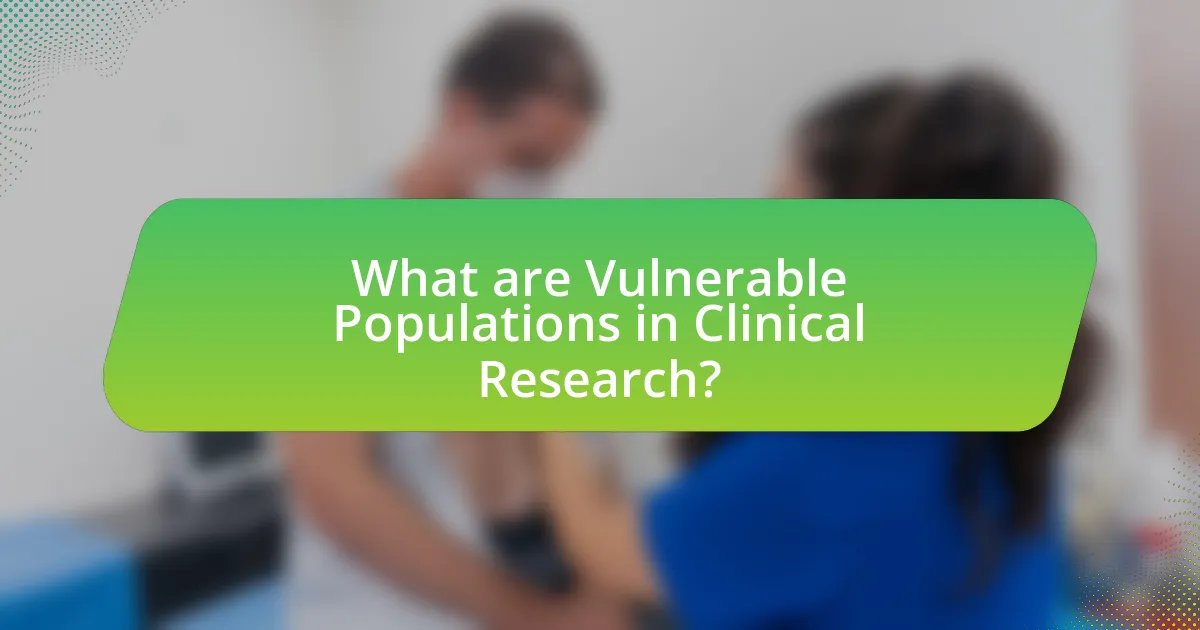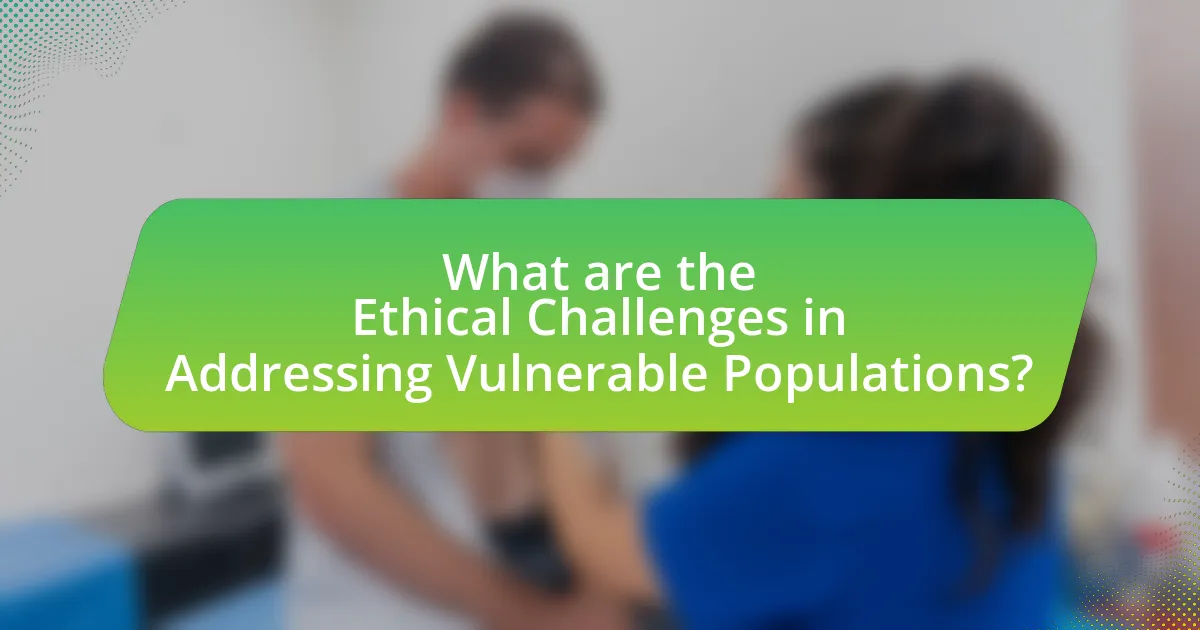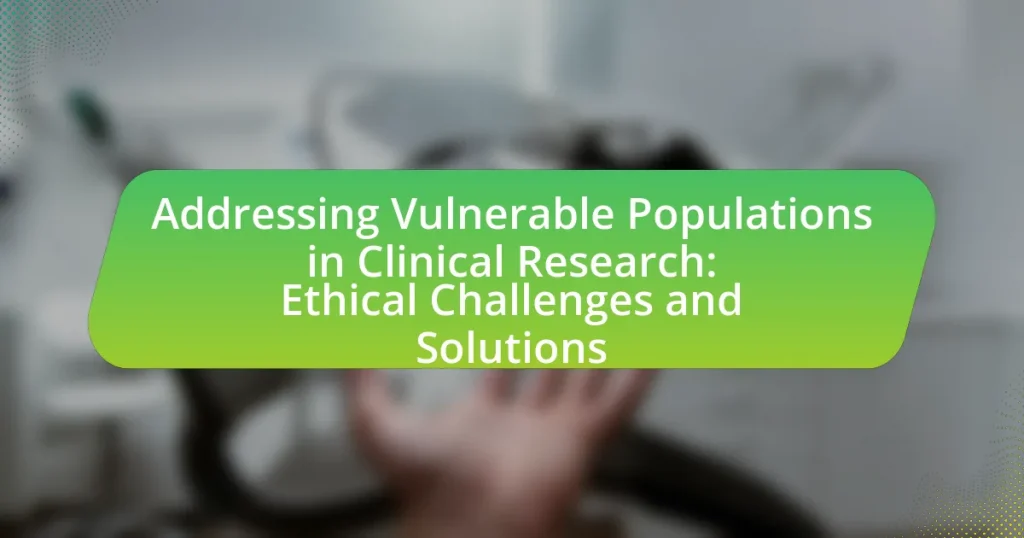Vulnerable populations in clinical research refer to groups at increased risk of adverse effects due to factors such as age, socioeconomic status, and health conditions. This article examines the ethical challenges associated with researching these populations, including issues of informed consent, exploitation, and the need for equitable access to research benefits. It highlights the characteristics that define vulnerability, the impact of social and economic factors, and the importance of ethical guidelines to protect these groups. Additionally, the article discusses strategies for improving informed consent processes, enhancing community engagement, and the role of regulatory frameworks in safeguarding vulnerable individuals in clinical research.

What are Vulnerable Populations in Clinical Research?
Vulnerable populations in clinical research are groups of individuals who may have an increased risk of experiencing adverse effects due to their circumstances, such as socioeconomic status, age, health conditions, or lack of decision-making capacity. These populations include children, the elderly, individuals with cognitive impairments, economically disadvantaged individuals, and those with chronic illnesses. The ethical considerations surrounding these groups are critical, as they often require additional protections to ensure informed consent and equitable treatment in research settings. For instance, the Belmont Report emphasizes the need for special safeguards to protect vulnerable populations, highlighting the ethical obligation to minimize risks and maximize benefits in research involving these groups.
Why are certain populations considered vulnerable in clinical research?
Certain populations are considered vulnerable in clinical research due to their increased susceptibility to coercion, exploitation, or harm. Vulnerable groups often include children, the elderly, individuals with cognitive impairments, economically disadvantaged individuals, and those with limited access to healthcare. These populations may lack the capacity to provide informed consent or may be in situations that make them more reliant on researchers, which raises ethical concerns about their protection. For instance, the Belmont Report emphasizes the need for additional safeguards for vulnerable populations to ensure their rights and welfare are prioritized in research settings.
What characteristics define vulnerable populations?
Vulnerable populations are defined by characteristics such as socioeconomic disadvantage, limited access to healthcare, and heightened susceptibility to health risks. These groups often include individuals with low income, racial and ethnic minorities, the elderly, children, and those with disabilities. For instance, according to the World Health Organization, socioeconomic factors significantly impact health outcomes, leading to disparities in access to medical services and overall health status. Additionally, research indicates that marginalized communities face barriers such as language differences and lack of education, further exacerbating their vulnerability in clinical settings.
How do social, economic, and health factors contribute to vulnerability?
Social, economic, and health factors significantly contribute to vulnerability by creating barriers that limit access to resources and opportunities. Individuals from lower socioeconomic backgrounds often face challenges such as inadequate education, unemployment, and limited access to healthcare, which exacerbate their vulnerability. For instance, research indicates that people living in poverty are more likely to experience chronic health conditions, which further restricts their ability to participate in clinical research and access necessary medical care. Additionally, social factors like discrimination and social isolation can lead to mental health issues, compounding the effects of economic and health disparities. These interconnected factors create a cycle of vulnerability that is difficult to break, as evidenced by studies showing that marginalized populations often have poorer health outcomes and reduced participation in health-related research.
What ethical considerations arise when researching vulnerable populations?
Researching vulnerable populations raises several ethical considerations, primarily centered around informed consent, potential exploitation, and the need for additional protections. Informed consent must be carefully obtained, ensuring that individuals fully understand the research and its implications, as vulnerable populations may have limited capacity to comprehend complex information. Additionally, researchers must guard against exploitation, as these groups may be more susceptible to coercion or undue influence due to their circumstances. The Belmont Report emphasizes the necessity of justice, which mandates equitable selection of research subjects and the minimization of risks while maximizing benefits. Furthermore, ethical guidelines often require that researchers implement additional safeguards, such as oversight by Institutional Review Boards, to protect the rights and welfare of vulnerable participants.
How does informed consent differ for vulnerable groups?
Informed consent for vulnerable groups differs primarily in the need for additional safeguards to ensure comprehension and voluntariness. Vulnerable populations, such as children, individuals with cognitive impairments, or those facing socioeconomic disadvantages, may lack the capacity to fully understand the implications of their participation in research. Consequently, researchers must implement tailored communication strategies, simplify consent forms, and provide additional support to facilitate understanding. For instance, the Belmont Report emphasizes the necessity of protecting these groups by ensuring that consent processes are not only clear but also considerate of their unique circumstances, thereby reinforcing ethical standards in clinical research.
What risks are associated with including vulnerable populations in clinical trials?
Including vulnerable populations in clinical trials poses several risks, primarily related to exploitation, informed consent, and health disparities. Vulnerable groups, such as children, the elderly, or individuals with cognitive impairments, may not fully understand the implications of participation, leading to issues with informed consent. Additionally, these populations may be more susceptible to coercion or undue influence, increasing the risk of exploitation. Research indicates that marginalized groups often face greater health disparities, which can be exacerbated by trial participation if the interventions do not adequately address their specific needs. For instance, a study published in the Journal of Medical Ethics highlights that without proper safeguards, vulnerable populations may experience adverse effects that are not adequately monitored or addressed.

What are the Ethical Challenges in Addressing Vulnerable Populations?
Ethical challenges in addressing vulnerable populations include issues of informed consent, exploitation, and equitable access to research benefits. Informed consent can be problematic as vulnerable individuals may lack the capacity to fully understand the implications of participation due to factors like cognitive impairments or socioeconomic disadvantages. Exploitation occurs when researchers take advantage of these populations, often due to their limited options or coercive circumstances. Furthermore, equitable access to the benefits of research is often lacking, as vulnerable groups may not receive the same level of care or access to interventions developed from studies they participated in. These challenges are underscored by historical instances, such as the Tuskegee Syphilis Study, which highlighted the need for ethical safeguards in research involving marginalized groups.
How do power dynamics affect the treatment of vulnerable populations in research?
Power dynamics significantly influence the treatment of vulnerable populations in research by often leading to exploitation and inadequate informed consent. Vulnerable groups, such as low-income individuals or marginalized communities, may lack the resources or knowledge to fully understand the implications of their participation, resulting in a power imbalance between researchers and participants. This imbalance can manifest in coercive recruitment practices, where individuals feel pressured to participate due to their socio-economic circumstances. Research has shown that ethical breaches frequently occur in studies involving these populations, as highlighted in the Belmont Report, which emphasizes the need for respect and justice in research practices. Furthermore, studies indicate that marginalized groups are often underrepresented in research, leading to a lack of consideration for their specific needs and perspectives, thereby perpetuating systemic inequalities.
What role does exploitation play in clinical research involving vulnerable groups?
Exploitation in clinical research involving vulnerable groups often manifests as the unjust treatment of individuals who may lack the capacity to provide informed consent or who are in precarious situations. This exploitation can lead to the coercion of participants into studies that may not benefit them, while primarily serving the interests of researchers or sponsors. Historical instances, such as the Tuskegee Syphilis Study, illustrate how vulnerable populations, particularly marginalized communities, have been subjected to unethical research practices without proper oversight or consideration for their well-being. Such exploitation raises significant ethical concerns, necessitating stringent regulations and ethical guidelines to protect these groups and ensure that their participation in research is both voluntary and beneficial.
How can bias impact the outcomes of studies involving vulnerable populations?
Bias can significantly distort the outcomes of studies involving vulnerable populations by leading to misrepresentation of their needs and experiences. For instance, if researchers hold preconceived notions about a vulnerable group, they may design studies that overlook critical factors affecting that population, resulting in findings that do not accurately reflect their realities. A study published in the Journal of Medical Ethics highlighted that biases in recruitment and data interpretation can lead to underrepresentation of certain demographics, ultimately skewing results and recommendations. This misrepresentation can perpetuate health disparities and hinder the development of effective interventions tailored to those populations.
What are the implications of inadequate representation of vulnerable populations?
Inadequate representation of vulnerable populations in clinical research leads to significant disparities in health outcomes and the effectiveness of treatments. When these populations are underrepresented, research findings may not be applicable to them, resulting in a lack of tailored healthcare solutions. For instance, studies have shown that clinical trials often exclude individuals from low-income backgrounds or racial minorities, which can perpetuate health inequities. A report by the National Institutes of Health highlights that diverse representation in research is crucial for understanding how different demographics respond to treatments, thereby ensuring that all groups benefit from medical advancements.
How does lack of representation affect the validity of research findings?
Lack of representation significantly undermines the validity of research findings by introducing bias and limiting the generalizability of results. When specific populations, particularly marginalized or vulnerable groups, are underrepresented in clinical studies, the findings may not accurately reflect the health outcomes or responses of those groups. For instance, a study published in the Journal of the American Medical Association found that clinical trials often exclude women and minorities, leading to a gap in understanding how treatments affect these populations. This exclusion can result in ineffective or harmful medical recommendations for those groups, as the data does not account for their unique biological, social, and environmental factors. Thus, the absence of diverse representation in research compromises the integrity and applicability of the findings across different demographics.
What are the potential consequences for public health policy?
The potential consequences for public health policy include increased health disparities and ethical dilemmas in research practices. When vulnerable populations are inadequately represented in clinical research, public health policies may fail to address their specific health needs, leading to inequitable access to healthcare services. For instance, studies have shown that marginalized groups often experience worse health outcomes due to a lack of tailored interventions, as evidenced by the disparities in chronic disease management among racial and ethnic minorities. Additionally, ethical challenges in obtaining informed consent from these populations can undermine the integrity of research, resulting in policies that do not reflect the realities of those most affected.

What Solutions Exist to Address Ethical Challenges in Clinical Research?
Solutions to address ethical challenges in clinical research include implementing robust informed consent processes, establishing independent ethics committees, and enhancing transparency in research practices. Informed consent ensures that participants fully understand the risks and benefits of their involvement, which is crucial for ethical integrity. Independent ethics committees review research proposals to safeguard participant welfare and ensure compliance with ethical standards. Additionally, transparency in reporting results and funding sources fosters trust and accountability, which are essential for ethical research. These solutions are supported by guidelines from organizations such as the World Health Organization and the Declaration of Helsinki, which emphasize the importance of ethical considerations in research involving human subjects.
How can researchers ensure ethical practices when involving vulnerable populations?
Researchers can ensure ethical practices when involving vulnerable populations by obtaining informed consent, ensuring equitable selection, and implementing safeguards against exploitation. Informed consent must be clear and comprehensible, allowing participants to understand the risks and benefits of their involvement. Equitable selection involves ensuring that vulnerable groups are not unfairly targeted or excluded from research benefits. Safeguards, such as independent oversight and monitoring, help protect participants from potential harm. These practices are supported by ethical guidelines established by organizations like the Belmont Report, which emphasizes respect for persons, beneficence, and justice in research involving human subjects.
What strategies can be implemented to enhance informed consent processes?
To enhance informed consent processes, researchers can implement strategies such as simplifying consent documents, utilizing visual aids, and providing tailored information sessions. Simplifying consent documents ensures that participants, especially those from vulnerable populations, can easily understand the information presented. Visual aids, such as diagrams or videos, can further clarify complex concepts, making the process more accessible. Tailored information sessions allow researchers to address specific concerns and questions from participants, fostering a more supportive environment. These strategies are supported by studies indicating that clear communication and participant engagement significantly improve understanding and retention of consent information, ultimately leading to more ethical research practices.
How can community engagement improve research outcomes for vulnerable groups?
Community engagement can significantly improve research outcomes for vulnerable groups by ensuring that their specific needs and perspectives are incorporated into the research process. Engaging these communities fosters trust, enhances recruitment and retention rates, and leads to more relevant and culturally sensitive research questions. For instance, studies have shown that when researchers involve community members in the design and implementation of health interventions, the resulting programs are more effective and better received. A notable example is the Community-Based Participatory Research (CBPR) approach, which has demonstrated improved health outcomes in various vulnerable populations by actively involving them in the research process. This method not only empowers communities but also leads to findings that are more applicable and beneficial to the populations being studied.
What role do regulatory frameworks play in protecting vulnerable populations?
Regulatory frameworks play a crucial role in protecting vulnerable populations by establishing guidelines and standards that ensure their rights and welfare are prioritized in clinical research. These frameworks, such as the Belmont Report and the Declaration of Helsinki, mandate informed consent, equitable selection of subjects, and additional safeguards for individuals who may be at increased risk of exploitation or harm. For instance, the U.S. Department of Health and Human Services regulations (45 CFR 46) specifically require that research involving vulnerable groups, such as children or economically disadvantaged individuals, includes additional protections to mitigate risks and ensure ethical treatment. This structured oversight helps to prevent abuse and promotes ethical standards in research, thereby safeguarding the interests of those who may not be able to advocate for themselves effectively.
How can existing guidelines be improved to better serve vulnerable populations?
Existing guidelines can be improved to better serve vulnerable populations by incorporating participatory approaches that actively involve these groups in the development and implementation of the guidelines. Research indicates that when vulnerable populations, such as low-income individuals or racial minorities, are engaged in the decision-making process, the resulting guidelines are more relevant and effective in addressing their specific needs (Fisher et al., 2019, Journal of Medical Ethics). Additionally, enhancing cultural competency training for researchers and ensuring that guidelines are adaptable to local contexts can further improve their applicability and effectiveness for vulnerable populations.
What best practices should researchers adopt to uphold ethical standards?
Researchers should adopt informed consent, transparency, and respect for participants as best practices to uphold ethical standards. Informed consent ensures that participants fully understand the nature of the research, its risks, and their rights, which is crucial for ethical integrity. Transparency involves openly sharing research goals, methods, and potential conflicts of interest, fostering trust between researchers and participants. Respect for participants includes safeguarding their privacy and autonomy, particularly for vulnerable populations, as highlighted in the Belmont Report, which emphasizes the principles of respect for persons, beneficence, and justice in research ethics.
What practical steps can researchers take to mitigate risks for vulnerable populations?
Researchers can mitigate risks for vulnerable populations by implementing informed consent processes that are culturally sensitive and easily understandable. This approach ensures that participants fully comprehend the study’s purpose, risks, and benefits, which is crucial for ethical research practices. Additionally, researchers should establish strong community partnerships to build trust and facilitate open communication, allowing for the identification of specific needs and concerns within the population. Furthermore, employing data protection measures to safeguard personal information is essential, as it helps to prevent potential exploitation or harm. Evidence from the Belmont Report emphasizes the importance of respect for persons, beneficence, and justice, which are foundational principles in protecting vulnerable groups in research settings.






